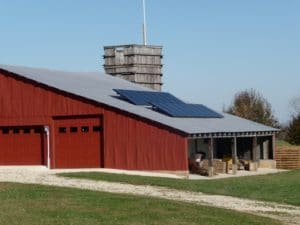Sustainable Farm uses Solar Energy

Twelve years ago Bob and Pat Belshe bought their farm in Cuba, Missouri to have a place to relax in the country. Over the years they invested in a number of conservation projects to create a more sustainable farm operation, and were awarded the “Farmer of the Year” by the local district of USDA and Natural Resources Conservation Service for their conservation and modern farming efforts. To truly “walk his talk,” Bob knew he wanted to start using renewable energy on their farm to reduce his carbon footprint and make his operation more sustainable.
With the property sitting on a ridge that always seemed to enjoy a strong breeze, Bob thought it would be a great place to install a wind turbine. When he contacted The Energy Savings Store, a company that specializes in wind and solar energy solutions, they convinced him that solar would be a better option. In this area of Missouri, wind speeds average 8-11 mph, which is strong enough to produce electricity, but without a very good return on the investment. However, the south-facing roof on his barn made a perfect structure to house a solar photovoltaic (PV) system.
Since the home on the farm is primarily used only on the weekends, the system was designed to offset a significant portion (about 37%) of the power used. The Energy Savings Store designed and installed a 3.6 kilowatt (kW) system, consisting of sixteen panels mounted in two rows across the roof. The 225 watt SunPower panels, which have the highest efficiency ratings in the industry, were expected to produce a little over 5,000 kilowatt hours (kWh) of electricity per year. While solar electric systems have a power rating measured in kW, the output – which is measured in kWh – is what’s most important, because that’s how you are billed for your electric usage. The average home uses about 12,000 kWh of electricity a year, and the Belshe farm uses about 13,500.
The net cost of the system was reduced by 30% because of the expansion of the federal tax credits available for renewable energy. In February 2009, the American Recovery and Reinvestment Act was passed, which removed the original $1500 cap on the tax credits. With the installed cost of PV systems averaging around $8,000 per installed kilowatt, this amounts to a substantial savings. And since the farm is actually a business, the Belshes were also able to take advantage of bonus and accelerated depreciation options. “This has been an excellent investment, and strengthens our commitment to operating a sustainable farm,” said Belshe.
One great way to look at solar is that you’re essentially purchasing 30 years of electricity at a fixed cost. While most panels have a 10-year warranty against defects, they typically last 40-50 years because there are no moving parts. Solar panels do degrade slightly over time – about 1% a year – but most manufacturers provide a second warranty that promises the system will continue to provide at least 80% of the output as when they were new. The system’s inverter, which converts the electricity from its native DC power (like that used in batteries) to AC, usually needs to be replaced after about 20 years, so you have to figure that into the 30 year cost. The Belshes estimated their net fixed cost p/kWh at about 15 cents p/kWh.
This is certainly higher than the current rate they’re paying for electricity, which is about 10 cents p/kWh. However, electric rates are conservatively projected to rise 5.5% per year over the next 25 years, which will increase the Belshe’s rate to 16 cents in 10 years, and to over 47 cents in 30 years. By taking these cost increases into consideration, 15 cents starts to look like a very good price to lock into!
Because the Crawford County farm is served by an electric cooperative, Crawford Electric, they were not able to take advantage of the $2 per watt utility rebate that Ameren customers can get starting in 2010. Had this been available, the Belshes would have saved an additional $5,000 and the fixed cost p/kWh would have been about 11 cents. The rebate, which is based off the 3.6 kW power rating, would have been $7,200, slightly lessening the federal tax credit that is taken off the rebated price.
After the installation, the system was inspected by Crawford Electric. They were pleased with the tidy installation, and impressed to see that more than half of the electricity produced was returned to the grid since the system had been installed. This is due to net-metering, which enables the bi-directional electric meter to spin backward when more electricity is produced than consumed.
“We’re very pleased to be using the clean, renewable energy of the sun on our farm,” claimed Belshe. For a video tour with more details about the system, check out Bob’s story on YouTube.
This article was published in the St. Louis Globe-Democrat in my new column The Green Life.
